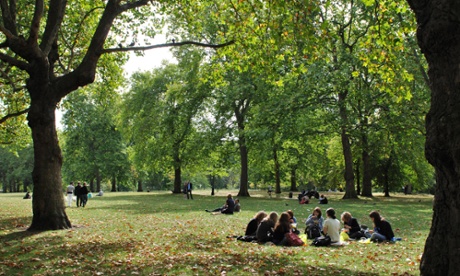
The national park concept should be extended from the countryside to the urban jungle, say the backers of a bid to have Greater London declared the world’s first “national park city”.
Advocates of the idea want to increase London’s green spaces, which currently make up 47% of its total land area, to 51% by 2051, and to help children connect with nature.
Daniel Raven-Ellison, the founder of the initiative, which publishes its proposal on Tuesday online and in 50,000 mock newspapers distributed in the capital, said:“London faces a whole range of challenges; air quality, water quality, the threat to protected green spaces, the lack of children playing outside and childhood obesity.
“What if we took learning from how national parks overcome these and apply it to the city context? Physically the city would be greener, with more forest cover and far more children would be learning and playing outdoors,” he said.
Strategies would range from the small-scale, such as promoting hedgehog passages through garden fences, to urban-scale ideas, such as converting railway lines into biodiverse corridors of flora and fauna.
London already benefits significantly from its green spaces, with its 8.3m trees generating £195m of air filtration services, according to engineering company Aecom.
However, much more can be made of this, suggests Raven-Ellison. “The green spaces around social housing cover a greater area than the 3,000 parks in London combined, but much of this space is inaccessible and under-used,” he said. “What if the quality of this land could become as high as what we see in our national parks?”
While about 400,000 people live across the UK’s 15 existing national parks, London is home to 8.6 million people. This means the city would fail to meet the International Union for Conservation of Nature’s standard for national parks.
Instead, suggests Raven-Ellison, a new definition is needed for a national park city as “a large urban area that is managed and semi-protected through both formal and informal means to enhance the natural capital of its living landscape.”
However, the proposal for a national park city would not focus on planning, bureaucracy and regulation, but instead on community and best practice.
“A large proportion of London is already protected,” said Raven-Ellison. “What a national park city would do is focus on the non-planning things that other national parks do, in particular, inspiring and educating people.”
“If we want children to care what’s going on in the Pacific Ocean, we need to find ways for children to respect nature on their own doorstep,” he added.
According to Paul Hamblin, executive director of National Parks England, a national city park for London would certainly look and feel different to the UK’s established national parks, but this would not devalue their identity.
“The beauty in this intriguing idea is how it can inspire a greater connection between where millions of people live and the natural world around them,” he said.
“I think those promoting the idea recognise that a national park city would not be exactly the same as our traditional national parks – Woolwich is not the same as Windermere. And yet the principles underpinning national parks are powerful and worth exploring for how they can be adapted to a city. And that is the exciting debate that is now flourishing in the capital.”

